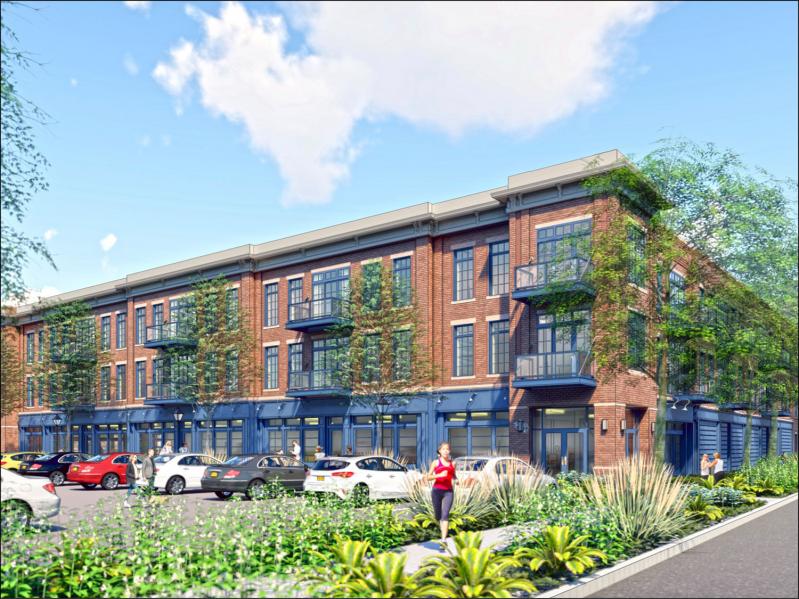Opponents of Adam Potter’s proposed mixed-use building at 7 and 11 Bridge Streets in Sag Harbor lined up to denounce the project during a village planning board hearing Tuesday, repeating complaints voiced last month about flooding, parking, traffic, and contamination from incomplete environmental remediation at the site.
Mr. Potter has proposed replacing an existing one-story commercial building and a one-and-a-half-story frame dwelling on the roughly one-acre property with an 81,257-square-foot building with 48 apartment units, 8,576 square feet of service-oriented commercial space, and a 16,554-square-foot internal parking garage. Also proposed are 134 parking spaces, 41 on site and 93 on the adjacent property at 5 Bridge Street.
The property is in the office, waterfront, historic, and tidal flood hazard overlay districts. Special exception approval is required to allow apartments in the office district and to build a structure larger than 3,500 square feet in the waterfront overlay district. The project would also require several variances including maximum residential unit density, maximum number of stories, minimum rear yard, allowance for off-site parking, allowance for enclosed areas below base flood elevation, and relief from the development standards for the proposed parking at 5 Bridge Street.
Tuesday’s meeting was a continuation of the April 22 hearing on draft environmental impact statement for the project. While board members gave little indication of their assessment of the application, an attorney representing the civic organization Save Sag Harbor noted that just hours earlier both he and the planning board had received a memo from the village’s zoning board of appeals, which he said detailed deficiencies in information. While the planning board is the lead agency on the application, the Z.B.A. would have to grant the needed variances.
The developer applied to New York State for the cleanup of the property as a potential Brownfields site, at which environmental contamination may complicate expansion, redevelopment, or reuse of a property. The lots on which Mr. Potter wants to build were previously part of a Superfund site, as designated by the federal Environmental Protection Agency, that is administered by National Grid. An environmental easement constrains the property so that the utility company can fulfill its requirements of a site management plan, negotiated with the New York State Department of Environmental Conservation.
The draft environmental impact statement was required because the planning board determined in April 2024 that the proposed development could have a significant environmental impact on the constrained site. The board voted unanimously in March to deem the D.E.I.S. complete in order to initiate a public review.
At the meeting on Tuesday, Chris Cobb, treasurer of the Sag Harbor Historical Museum, read a statement on the museum’s behalf expressing strong opposition to the project. Its board of trustees, he said, specifically objects to demolition of the 19th-century house at 7 Bridge Street, which he said is eligible for landmarking listing. The proposal would also create a detrimental visual impact in the heart of the commercial district, he said. “The scale of this mixed-use scheme is too large,” he said, and the proposal would be “destructive to the fabric of the village” and “incompatible with the scale and character of our village.”
Angela Inzerillo also spoke of the scale of the local architecture and objected to the plan to demolish historic structures. “Approving this plan erases Sag Harbor’s history,” she said. “It is unconscionable to think we would contemplate to ruin our own village by choice.” The proposed development is not only in a flood zone, she said, but Mr. Potter is requesting “a significant amount of impervious surfaces and septic challenges, not to mention parking.” Variances, she said, are a last resort when all options to conform to the zoning code have been exhausted. Approving the development would “set a dangerous precedent going forward,” she warned.
Jeff Bragman, the attorney representing Save Sag Harbor, made the most detailed presentation to argue against approval. The zoning board’s memo, he said, is relevant to the planning board’s deliberations, and the planning board must take into account the potential impacts of variances in Mr. Potter’s application. “It seems to me you would want time to look that over and come to your own conclusions” he said. “The planning board has every right to continue these proceedings as long as you need to, to get the information you need.”
“There are so many unknowns here,” Mr. Bragman continued. “The sewage management is completely unknown to you. . . . You don’t know anything about the remedial action plan that they’re going in front of the D.E.C. for, we don’t know what the outcome is going to be.” Two related issues, he added, are critical. One is dewatering the site, which is done to create a dry and stable work environment, and the other is pile driving to install foundations. “Both of those issues directly impact groundwater quality and the potential dissemination of contaminants into the groundwater,” he said, “because if you dewater, you’re pulling water out of the ground through the peat layer, and there’s a risk that you’re going to disseminate contamination when you drive piles.”
The proposed building is “enormous,” he said, “too large for the site, so the applicant tries to make the site fit the building by getting variances.” Common sense, he said, “suggests a smaller project.” On-site parking is “impossible to meet,” necessitating its placement off site, which he said demonstrates that the site is inadequate for its intended purposes and is relevant to the planning board’s consideration as to whether or not the proposal would have an adverse impact.
“Planning means ‘know before you go,’ not ‘yes, and figure it out later,’ “ he said.
The planning board closed the public hearing on the D.E.I.S., but left the record open for written comments until June 27.
Once the written comment period has closed, said John Ellsworth of the Nelson, Pope & Voorhis engineering firm, all comments received will be analyzed and detailed responses provided in the final environmental impact statement prepared by the planning board. That document will also be issued for public review.
A finding statement will follow that synthesizes information in the draft and final environmental impact statements, which Mr. Ellsworth explained will provide a conclusion as to whether the project is approvable based on the impacts and the mitigation provided, and weighed against any benefits it may offer.




